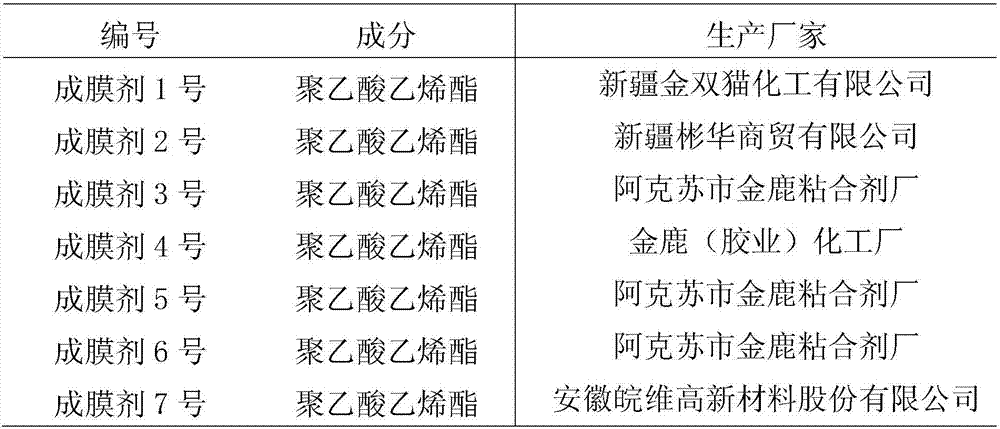Protective agent for wounds of forest trees
A technology of wound protection agent and tree, applied in biocides, disinfectants, bactericides, etc., can solve the problems of secondary damage to trees, secondary infection, cumbersome usage, etc., achieve strong rain erosion resistance, and promote wound healing The effect of healing and not polluting the environment
- Summary
- Abstract
- Description
- Claims
- Application Information
AI Technical Summary
Problems solved by technology
Method used
Image
Examples
Embodiment 1
[0040] Add 0.8g of α-naphthaleneacetic acid, 15g of tridemorpholine, 60g of ethanol and 40kg of polyvinyl acetate in the reaction kettle, and stir evenly to obtain a tree wound protection agent. (weight=15×0.75=11.25g of tridemorpholine)
[0041] A forest wound protection agent described in this example contains common raw materials. Polyvinyl acetate is used as a film-forming agent. Bacteria; tridemorpholine is used as a fungicide, which has a strong inhibitory effect on rot bacteria, and is environmentally safe, non-toxic and harmless, and has no pesticide residue; the α-naphthaleneacetic acid contained in it can effectively promote wound healing; according to the formula The obtained wound protection agent has obvious promoting effect on the wounds of fruit trees, and has simple operation, non-toxic and harmless, does not pollute the environment, is long-lasting, stable, resistant to rain, and does not cause secondary infection of the wound. The characteristics of low cost...
Embodiment 2
[0043] Add 1.2g of α-naphthaleneacetic acid, 15g of tridemorpholine and 60kg of polyvinyl acetate in the reaction kettle, stir evenly, and obtain the tree wound protection agent. (weight=15×0.75=11.25g of tridemorpholine)
[0044] A forest wound protection agent described in this example contains common raw materials. Polyvinyl acetate is used as a film-forming agent. Bacteria; tridemorpholine is used as a fungicide, which has a strong inhibitory effect on rot bacteria, and is environmentally safe, non-toxic and harmless, and has no pesticide residue; the α-naphthaleneacetic acid contained in it can effectively promote wound healing; according to the formula The obtained wound protection agent has obvious promoting effect on the wounds of fruit trees, and has simple operation, non-toxic and harmless, does not pollute the environment, is long-lasting, stable, resistant to rain, and does not cause secondary infection of the wound. The characteristics of low cost.
Embodiment 3
[0046] Add 1g of α-naphthaleneacetic acid, 11.25g of tridemorpholine, 40g of xanthan gum and 50kg of polyvinyl acetate in the reaction kettle, and stir evenly to obtain a tree wound protection agent.
[0047] A forest wound protection agent described in this example contains common raw materials. Polyvinyl acetate is used as a film-forming agent. Bacteria; tridemorpholine is used as a fungicide, which has a strong inhibitory effect on rot bacteria, and is environmentally safe, non-toxic and harmless, and has no pesticide residue; the α-naphthaleneacetic acid contained in it can effectively promote wound healing; according to the formula The obtained wound protection agent has obvious promoting effect on the wounds of fruit trees, and has simple operation, non-toxic and harmless, does not pollute the environment, is long-lasting, stable, resistant to rain, and does not cause secondary infection of the wound. The characteristics of low cost.
PUM
 Login to View More
Login to View More Abstract
Description
Claims
Application Information
 Login to View More
Login to View More - R&D
- Intellectual Property
- Life Sciences
- Materials
- Tech Scout
- Unparalleled Data Quality
- Higher Quality Content
- 60% Fewer Hallucinations
Browse by: Latest US Patents, China's latest patents, Technical Efficacy Thesaurus, Application Domain, Technology Topic, Popular Technical Reports.
© 2025 PatSnap. All rights reserved.Legal|Privacy policy|Modern Slavery Act Transparency Statement|Sitemap|About US| Contact US: help@patsnap.com



